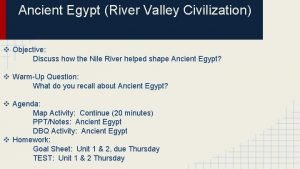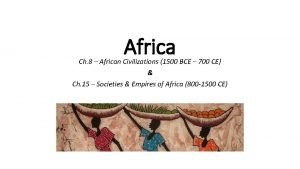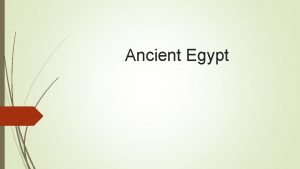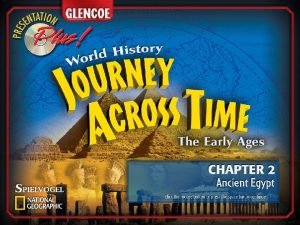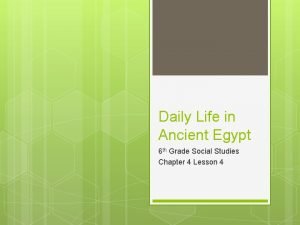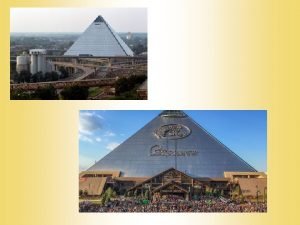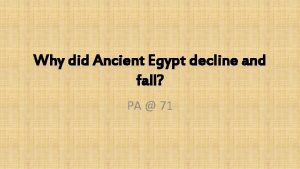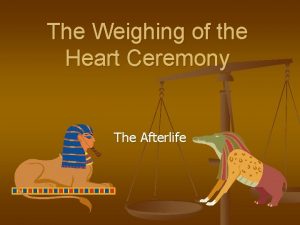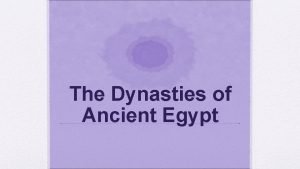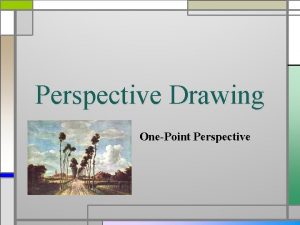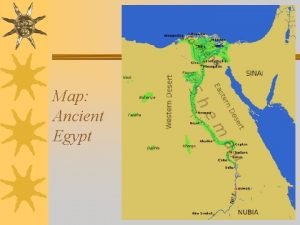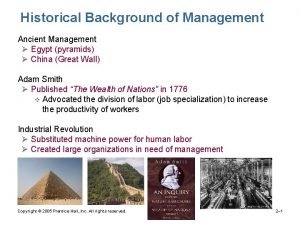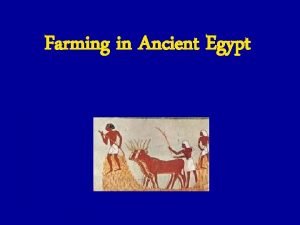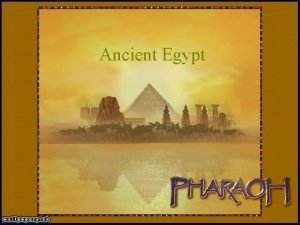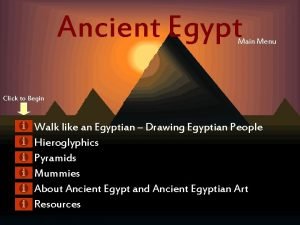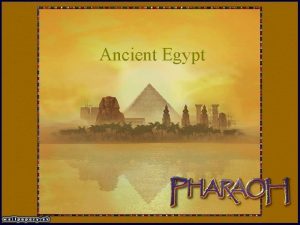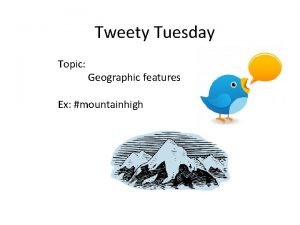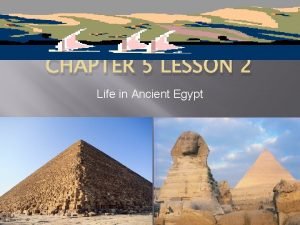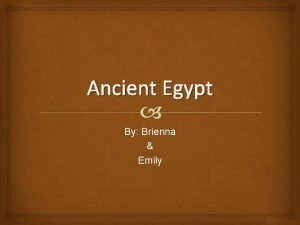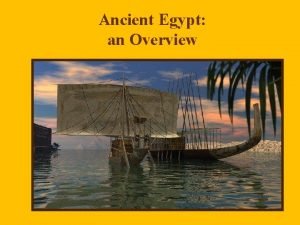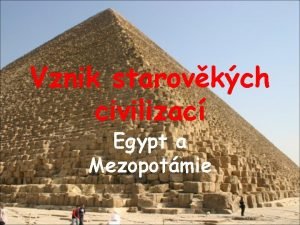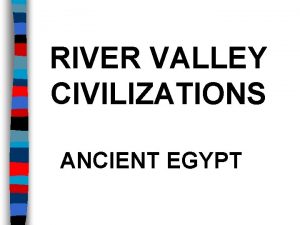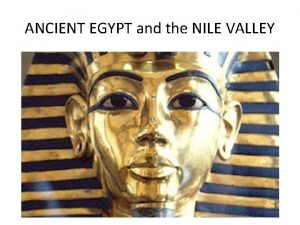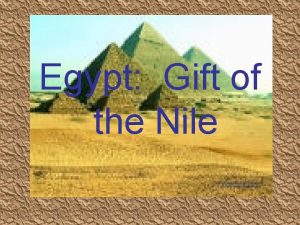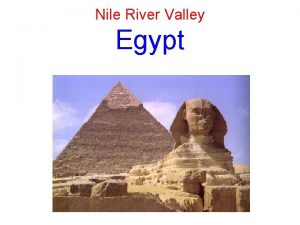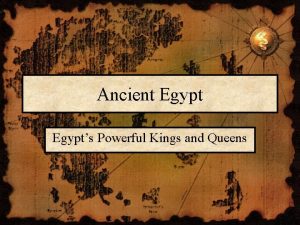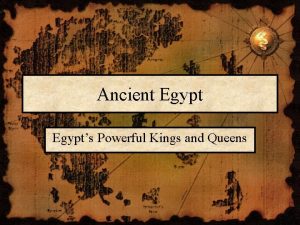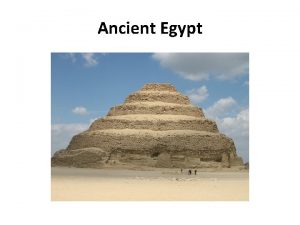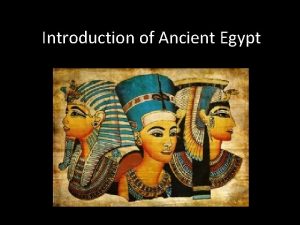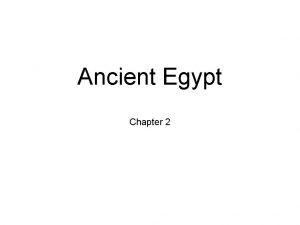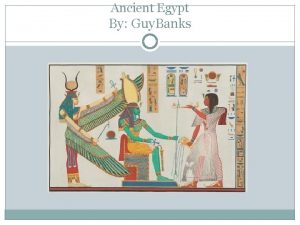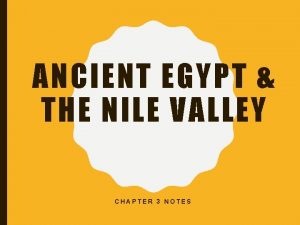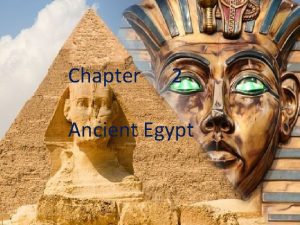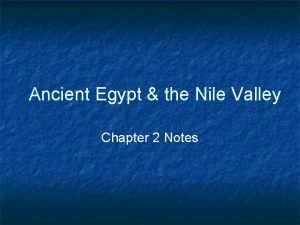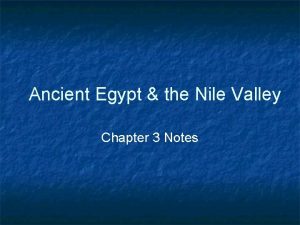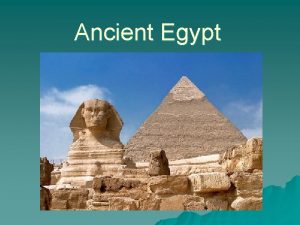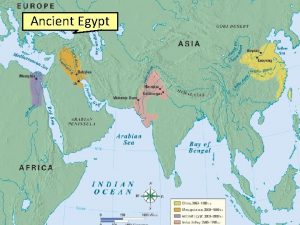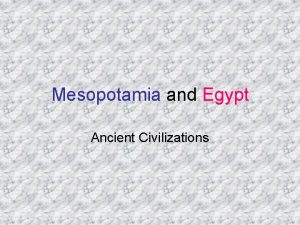Chapter 2 Ancient Egypt The Nile Valley Egypts




































- Slides: 36

Chapter 2 - Ancient Egypt -The Nile Valley -Egypt’s Old Kingdom -The Egyptian Empire -The Civilization of Kush

Sphinx

About Egypt § Located on the African Continent § Africa § World Map

The Great Sphinx of Giza § The Great Sphinx of Giza was considered by the ancients to be one of the Seven Wonders of the World § The Sphinx is oriented due east facing the rising sun § A sphinx is a mythical beast of ancient Egypt with the head of a man and the body of a lion, often symbolizing the pharaoh as an incarnation of the sun god Ra § The Egyptian government has refused permission for the chambers beneath the Sphinx to be excavated and explored

Did You Know? § After developing their method of papermaking using papyrus, the Egyptians kept the process secret, so others could not make paper. In this way, papyrus became even more valuable.

Preteaching Vocabulary What kind of government runs in the family? In a dynasty, leadership is passed from one generation to the next, usually from father to son. This is how government worked in Egypt.

The Nile Valley (pg. 38 -46) § I. Settling the Nile § The Nile River is the longest in the world, stretching for 4, 187 miles. The Nile flows from south to north and is formed by three major tributaries: the White Nile, the Blue Nile and the Atbara. § The ancient Egyptians called the river Ar or Aur, meaning "black, " because of the black sediment left behind after the frequent river floods. The ancient Greeks called the river Kem, which translates into "black" as well. But it is as Nile that we know this river today. Nile comes from the Greek Neilos, which means "river valley. " § Egyptians used the Nile River to drink, clean, farm, and cook. They ate fish from the river. § The Nile Valley is a narrow, green valley in Egypt. The northern end of the valley is a fertile area of land called a delta. § See map on page 39 and 40

Nile Delta

I. Settling the Nile § The Sahara, the largest desert in the world, lies west of the Nile Valley. The Eastern Desert lies to the east of the valley.

The Sahara Desert § The Sahara receives less than three inches of rain a year. § Oases make trade possible between the ports of North Africa and savanna markets further south. Without these wet rest stops for humans and animals, crossing the desert would be almost impossible. § As the world's biggest desert, the Sahara covers a third of the African continent-an area about the size of the United States. § The Sahara is one of the hottest places on Earth. Even though temperatures there may rise to 136 F (57. 7 C), its dryness, not heat, that makes a place like the Sahara a desert. The frozen continent of Antarctica is so dry that some scientists consider it a desert, too.

Sahara Desert § Many thousands of years ago, the Sahara was a green home to waterloving animals, like hippos. Then the climate changed. Today rising and falling winds pull moisture away from the desert, rarely bringing rain.

I. Settling the Nile § Egypt had several ‘natural borders’ to protect it. The deserts, dangerous rapids of the Nile, and marshes in the delta kept enemies from entering Egypt. § The Mediterranean Sea to the north and the Red Sea to the east allowed trade with other peoples. Within Egypt, people traveled on the Nile to trade with each other.

II. The River People § Floods along the Nile were predictable and were not devastating. § Each spring the Nile would flood and leave a dark, fertile mud along its banks. § Farmers learned about the waters of the Nile. They used the soil left behind by the floods to grow wheat, barley and flax seeds.

II. The River People § Farmers learned about irrigation. They dug basins to trap floodwaters, dug canals to channel water to the fields, and built dikes to strengthen the basin walls. § Papyrus was a reed plant that grew along the Nile that was used to make baskets, sandals, and river rafts. It was later used to make paper. § The Egyptians also developed a writing system called hieroglyphics. This system consisted of thousands of picture symbols. § Interdisciplinary connections activity on page 42

Egyptian Hieroglyphic Alphabet

III. A United Egypt § Because people in Egypt had a surplus of food, some became artisans instead of farmers. Artisans wove cloth, made pottery, carved statues, and crafted weapons and tools. § Egyptians traded with each other and with others in Mesopotamia. § Over time a few strong chiefs united groups of villages into kingdoms. Two kingdoms emerged: Lower Egypt and Upper Egypt.

III. A United Egypt § Narmer united the two kingdoms. He ruled from the city of Memphis. Narmer’s formed a dynasty. § Ancient Egypt was ruled by 31 dynasties that historians have grouped into three time periods: Old Kingdom, Middle Kingdom, and New Kingdom.

IV. Early Egyptian Life § Ancient Egypt had social Classes: § Pharaoh was the highest power. § Upper Class –nobles, priests, and gov. officials. § Middle Class-merchants, artisans, shopkeepers, and scribes. § Farmers were largest group of people and were in a lower class than the middle class. Unskilled workers were the lowest class of people in ancient Egypt.

IV. Early Egyptian Life § Women had more rights in Egypt than any other ancient civilizations. They could own property, buy and sell goods, make wills, and obtain divorces. § Few children went to school. They mostly played games and had toys. § Girls learned to sew, cook, and run a household. Boys learned farming or a skilled trade.

Ch. 2, Sec. 2 - Egypt’s Old Kingdom (pg. 47 -52) § Old Kingdom Rulers § Old Kingdom lasted from 2600 B. C. - 2300 B. C. § Pharaohs were all-powerful Egyptian kings who guided every activity in Egypt. § Egyptian people served pharaohs because they believed the kingdom depended on one strong leader. They also believed the pharaohs were the sons of Re, the sun god. They thought pharaohs were gods on earth.

II. Egypt’s Religion § Egyptians believed in many gods and goddesses, or deities. These deities controlled every human activity and all natural forces. § The major god was Re, the sun god. Hapi ruled the Nile River and Isis was the most important goddess.

II. Egypt’s Religion § Believed in life after death § Book of the Dead contained a collection of spells that Egyptians believed they needed to enter afterlife. § For centuries, Egyptians believed only pharaohs and a few elite people could have life after death. To protect the Pharaohs body they developed an embalming process.

Embalming process § Body’s organs removed (except heart) § Body was treated with spices and oils and wrapped with strips of linen. This wrapped body was called a mummy.

II. Egypt’s Science § Doctors used herbs and drugs to treat illnesses. They also set broken bones and stitched cuts. Egyptian doctors were first to specialize in different areas of medicine, and wrote the world’s first medical book.

Ancient Egypt § Egyptian Pyramids

III. The Pyramids § Built to protect bodies of dead pharaohs. Contained items the pharaohs might need in the afterlife. § Took thousands of people and years of labor to build. They used astronomy and mathematics to create the pyramids. § While studying the skies to create pyramids, Egyptians created the 365 -day calendar that became the basis for our calendar today. § The Great Pyramid is the largest pyramid in Egypt. It was built for King Khufu.

Ch. 2, Sec. 3 (pgs. 59 -67) The Egyptian Empire § I. The Middle Kingdom § Pharaohs lost control of Egypt in about 2300 B. C. At that time, a new dynasty of pharaohs created a capital at Thebes. § Egypt increased its riches during this time by forcing newly conquered lands to pay a tribute, or forced payment. § During the Middle Kingdom, the arts, literature, and architecture blossomed.

The Middle Kingdom § The Middle Kingdom ended when the Hyksos attacked and conquered Egypt. The Hyksos ruled until around 1550 B. C. , when the Egyptian prince Ahmose led a revolt to drive the Hyksos out of Egypt.

The New Kingdom § Ahmose’s reign ushered in the New Kingdom from about 1550 B. C. until 1080 B. C. § Hatshepsut was the first woman to rule Egypt. § Trade grew during her reign. Trade made Egypt wealthy. § Thutmose III became pharaoh after her death. Slavery became common during his reign. Slaves had some rights. They could own land, marry and eventually obtain freedom.

III. The Legacies of Two Pharaohs § Amenhotep IV came to power in 1370 B. C. § He felt priests were gaining too much power. He introduced a new religion with only one god. Priests who did not follow the new religion were removed from power. § He got so wrapped up in his new religion that he neglected his duties. Once, when the Hittites attacked, he did not act. Thus, the empire diminished greatly. § He even changed name to Akhenaton.

III. The Legacies of Two Pharaohs § Tutankhamen, now called King Tut, was a boy ruler who took power after Akhenaton died at the age of 10. He ruled for only 9 years before his death. In A. D. 1922, a British archaeologist found Tut’s grave. § updated history on Amenhotep and Tutankhamen

IV. The End of the New Kingdom § Ramses II was one of the most effective pharaohs of the New Kingdom § During his reign many temples were built. § After his rule Egypt began to decline. Egypt was attacked by neighboring groups and eventually controlled only the Nile delta.

Ch. 2, sec. 4 (pgs. 69 -72) § The region of Nubia, modern day Sudan, later known as Kush, was located south of Egypt on the Nile River. § The first people to arrive in Nubia were cattle herders, who grazed their herds on the Savanna. A savanna is a grassy plain.

II. The Rise of Kush § Nubians broke away from Egypt and formed their own kingdom called Kush. § Kushite kings ruled from city of Napata, which was along the upper Nile. § Assyrians later invaded Egypt and forced the Kushites out. The Kushites learned iron working from the Assyrians. They were the first Africans to use iron.

II. The Rise of Kush § Kush moved the ruling city to Meroe, further from the Assyrians. Kushite built Meroe to look like Egypt, with pyramids and temples. § Eventually Axum rose up and invaded Meroe and burned it to the ground.

THE END
 How did the nile shape ancient egypt
How did the nile shape ancient egypt How did the nile shape ancient egypt dbq answer key
How did the nile shape ancient egypt dbq answer key What lasting legacies did the aksum kingdom leave
What lasting legacies did the aksum kingdom leave Egypt is the gift of the nile
Egypt is the gift of the nile Janapriya nile valley
Janapriya nile valley Nile river valley advanced cities
Nile river valley advanced cities Why was napata location advantageous
Why was napata location advantageous Egypts middle kingdom
Egypts middle kingdom Egypts social pyramid
Egypts social pyramid Upper egypt and lower egypt
Upper egypt and lower egypt Why did ancient egypt fall
Why did ancient egypt fall Thoth weighing of the heart
Thoth weighing of the heart Byzantines floral design
Byzantines floral design Ancient egypt vocabulary words
Ancient egypt vocabulary words Frontalism art
Frontalism art The british council egypt
The british council egypt Specialized jobs in ancient egypt
Specialized jobs in ancient egypt Ancient egypt
Ancient egypt Ancient egypt map
Ancient egypt map Ancient management
Ancient management What crops did the egyptian farmers grow
What crops did the egyptian farmers grow Egypt cloth
Egypt cloth Ancient egyptian transportation
Ancient egyptian transportation Geographical map of ancient egypt
Geographical map of ancient egypt Ancient egypt social classes
Ancient egypt social classes What is frontalism
What is frontalism Ancient egypt map
Ancient egypt map Social classes
Social classes Trophic level
Trophic level Ancient egypt non chronological report
Ancient egypt non chronological report Egyptian social pyramid
Egyptian social pyramid Ancient egypt jeopardy
Ancient egypt jeopardy Ancient egypt basic needs
Ancient egypt basic needs The three kingdoms of ancient egypt
The three kingdoms of ancient egypt Kleopatra hrobka
Kleopatra hrobka Ancient egypt bell ringers
Ancient egypt bell ringers Ancient egypt specialized workers
Ancient egypt specialized workers

